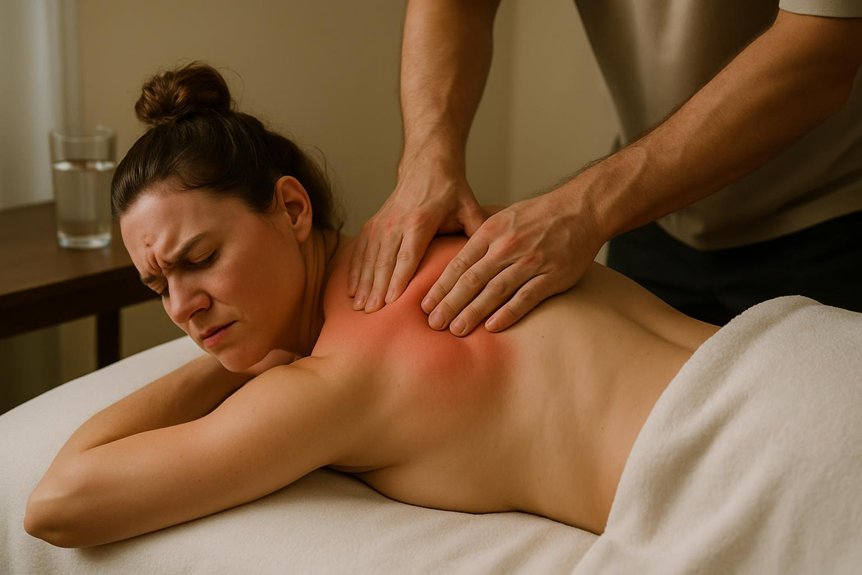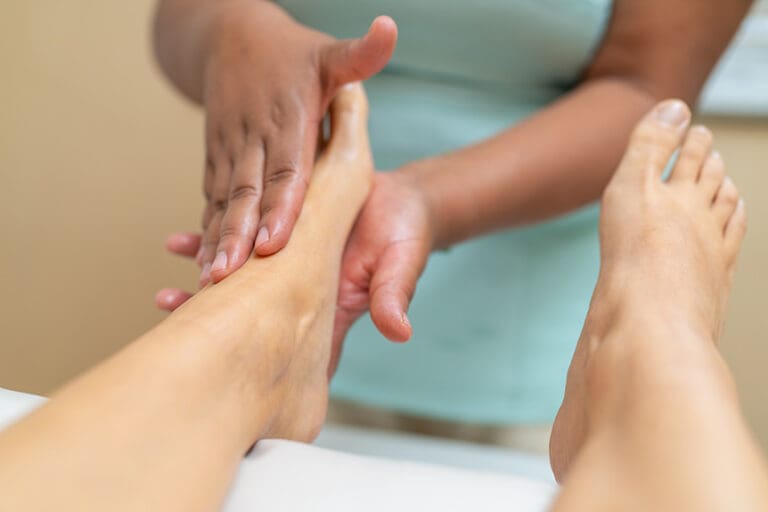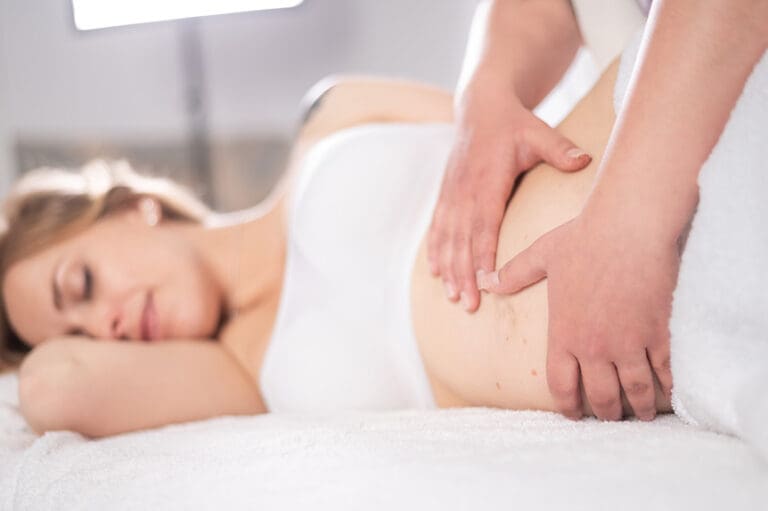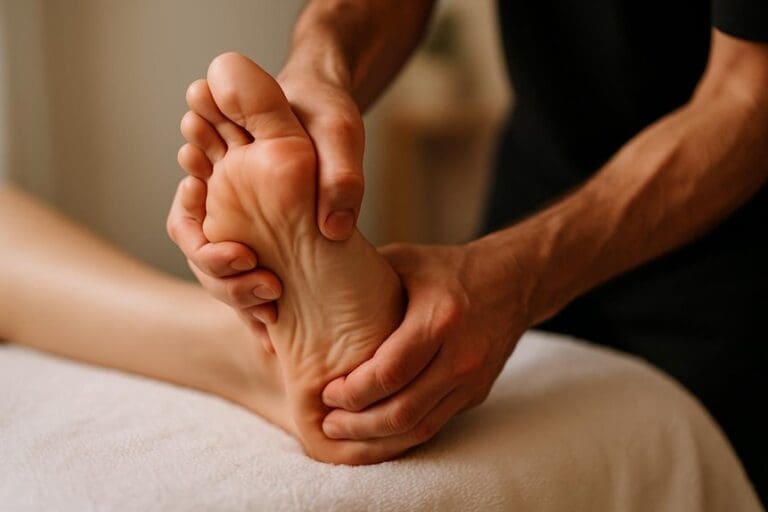A deep muscle therapy can trigger short‑lived, flu‑like discomfort in some people. Mild soreness, fatigue, light‑headedness, and increased urination are common as circulation and lymphatic flow rise and micro‑adhesions release. These reactions typically resolve within 24–48 hours with hydration, rest, and gentle movement. Seek professional advice for sharp pain, worsening swelling, numbness, severe headache, chest pain, or if on blood thinners, post‑surgery, pregnant, or with clotting disorders. Thoughtful pressure, pacing, and aftercare reduce risk and improve outcomes—here’s what helps.
Why You Might Feel Unwell After a Deep Muscle Therapy
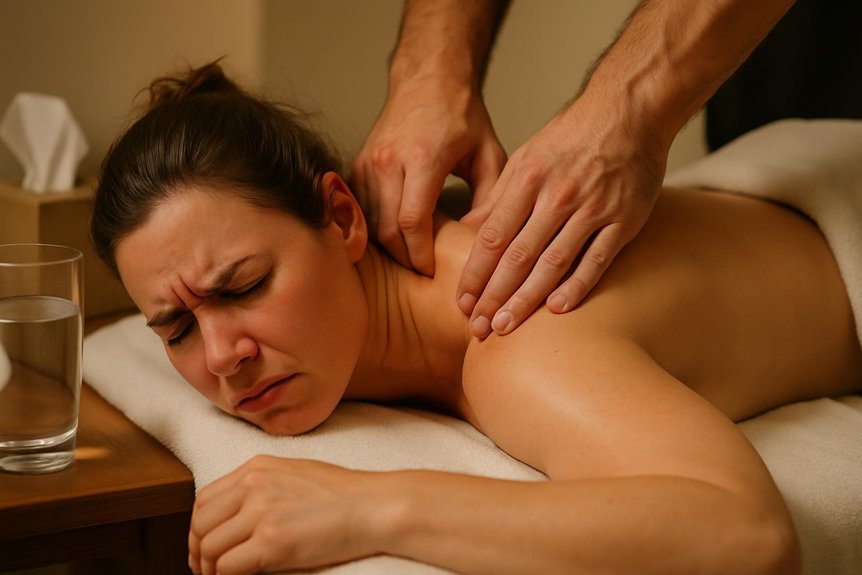
Why do some clients feel slightly unwell after a massage session?
Spa & Massage observes that brief post-session discomfort is not uncommon and typically resolves within 24–48 hours.
Clients may notice light fatigue, a dull headache, mild nausea, or tenderness. These reactions are more likely after a first treatment, a longer session, higher pressure, dehydration, inadequate food intake, poor sleep, elevated stress, or when multiple tense regions are addressed in one visit.
In our clinics, therapists pace intensity, warm tissues progressively, and check pressure to minimise adverse responses.
They recommend steady hydration, a balanced meal 1–2 hours beforehand, gentle movement after the session, and rest that evening.
Clients with ongoing symptoms, fever, dizziness, or significant pain should contact the clinic for tailored guidance.
Some practices, such as aromatherapy massage, can help support relaxation and healing, which may ease post-treatment discomfort.
What’s Actually Happening in Your Body During and After Treatment
During a deep tissue massage, mechanical pressure deforms skin, fascia, and muscle, triggering local and systemic responses that continue after the session. Mechanotransduction activates receptors in connective tissue, modulating muscle tone and pain signaling.
Local circulation increases, clearing metabolites and delivering oxygen; lymphatic flow is encouraged, assisting fluid balance. Micro-tears in adhesions can prompt mild, short-lived inflammation as tissues remodel.
Autonomic activity often shifts toward parasympathetic dominance—slowing heart rate and supporting digestive and restorative processes.
Neurochemical changes may follow: reduced cortisol, and altered levels of endorphins and serotonin, influencing comfort and mood.
At Spa & Massage in London, therapists tailor depth and pacing to the client’s goals, using graded pressure, precise holds, and paced breathing to enhance these physiologic effects while respecting individual sensitivity and recovery needs.
Common Post-Massage Reactions vs. Signs You Should Contact a Professional
Although responses vary by individual and treatment intensity, several post–deep tissue massage reactions are expected and self-limiting: transient muscle soreness (24–48 hours), mild fatigue, temporary lightheadedness, increased urination, and localized warmth or tenderness as circulation and lymphatic flow normalize.
Gentle movement, hydration, and unhurried rest usually settle these sensations. In our London clinics, therapists advise clients to monitor how discomfort trends—easing day by day is reassuring.
However, escalation or atypical features warrant professional input. Seek advice if pain becomes sharp or severe, bruising is extensive or worsening, swelling is pronounced, numbness or tingling persists, headache is intense with visual change, fever develops, or there is chest pain, shortness of breath, or new neurological weakness.
Those on anticoagulants, with clotting disorders, diabetes complications, recent surgery, or pregnancy should contact the clinic or their GP promptly if symptoms feel out of step.
How We Minimise Post-Treatment Discomfort at Spa & Massage
Building on what typical reactions look like and when to seek advice, Spa & Massage focuses on preventing discomfort through careful assessment, precise technique, and structured aftercare.
Each session begins with a brief health screen and palpation-led assessment to set pressure, pace, and goals.
Therapists modulate depth gradually, working layer by layer, and avoid prolonged ischemic holds on sensitised tissue.
Friction is reduced with hypoallergenic oils used in our clinics, and heat is applied selectively to ease guarding.
After treatment, clients receive tailored guidance: drink water to offset transient fluid shifts, perform gentle range‑of‑motion and diaphragmatic breathing, and use short, cool compresses for focal soreness.
Therapists recommend light movement the same day, spacing sessions appropriately, and checking in within 24–48 hours to refine the plan.
Who Should Be Cautious or Avoid Deep Muscle Therapy
When is it not the right choice? It may be unsuitable for clients with acute injuries, active inflammation, fever, uncontrolled hypertension, or severe osteoporosis. Those with bleeding disorders, on anticoagulants, or with fragile skin should avoid deep pressure due to bruising risk. Deep tissue work is contraindicated over varicose veins, open wounds, rashes, or recent surgical sites.
Individuals with cancer, diabetes with neuropathy, or autoimmune flares require medical guidance and modified techniques. Pregnancy warrants gentler, specialised care—our therapists recommend pregnancy massage instead.
People with a history of blood clots, recent fractures, or severe cardiovascular disease need clearance first. At Spa & Massage, therapists screen carefully, adjust pressure with consent, and prioritise comfort, ensuring intensity never overwhelms the body’s capacity to respond.
Practical Aftercare: Hydration, Rest, and Recovery Tips From Our Therapists
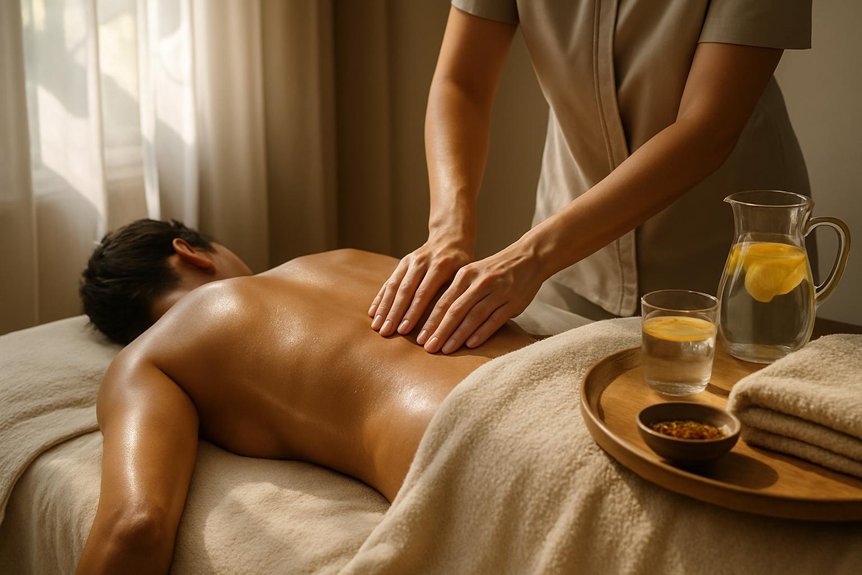
Following a massage session, Spa & Massage therapists advise a structured aftercare plan to optimise benefits and minimise soreness.
Hydration is prioritised: two to three glasses of water over the next few hours support circulation and reduce perceived heaviness.
Light, nutrient-dense meals and limited alcohol or caffeine help stabilise recovery.
Rest matters—gentle mobility (walking, easy stretching) prevents stiffness, while avoiding strenuous exercise for 24 hours reduces inflammation risk.
Warm showers or a brief Epsom salt soak may ease residual tenderness.
In our clinics, therapists suggest mindful breathing and unhurried pacing to settle the nervous system.
For sensitive areas, apply a cool compress for 10 minutes.
Seek balanced sleep, and note changes in pain, mood, or energy to guide future session goals.
When to Book, How Often to Come, and Adjusting Pressure for Your Needs
An effective scheduling plan balances symptom patterns, goals, and recovery capacity.
For acute pain or postural strain, our therapists at Spa & Massage typically suggest weekly deep tissue sessions for 2–3 weeks, then tapering to every 2–4 weeks for maintenance.
For stress and general wellbeing, a 3–4 week interval maintains benefits without oversensitising tissues.
Clients experiencing illness, fever, active infection, or significant inflammation should postpone until fully recovered.
Pressure is adjusted moment to moment. Our clinicians begin with moderate depth, monitor breath, muscle tone, and verbal feedback, then layer intensity gradually.
A “hurts-good” sensation is acceptable; sharp, guarding pain is not.
Sensitive areas receive slower pacing and smaller strokes.
After sessions that were deeper or longer, spacing appointments an extra week supports full tissue recovery and stable progress.
Conclusion
In the quiet after treatment, the body is a river clearing silt—temporary murk before clarity returns. Evidence shows transient soreness, fatigue, or headache often signal circulation shifts and neuromuscular recalibration, not harm. Spa & Massage guides this passage: measured pressure, screening, and aftercare—hydration, gentle movement, rest—serve as banks that steady the flow. Clients who notice red flags—severe pain, fever, dizziness, or worsening symptoms—should seek advice. With tailored pacing and frequency, mobility widens, and the water runs clear.
